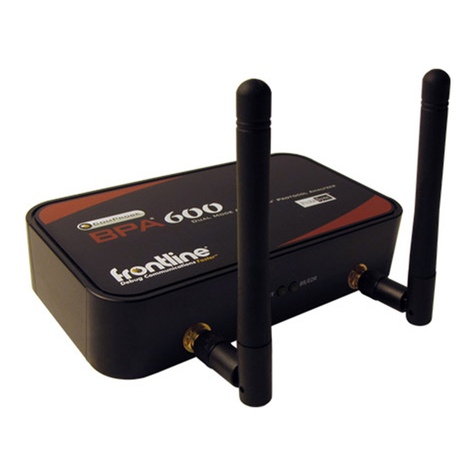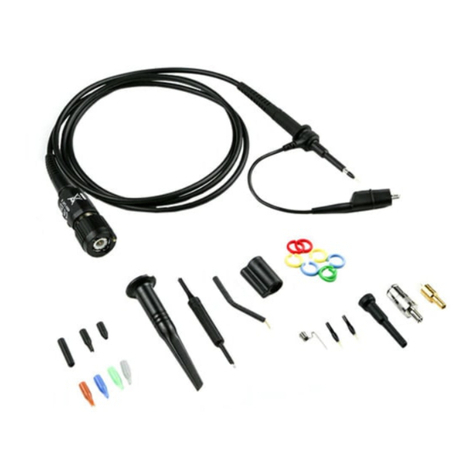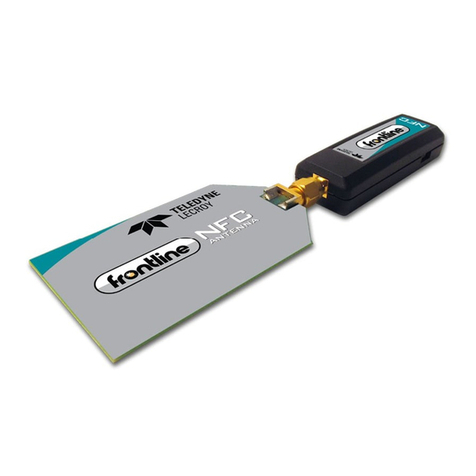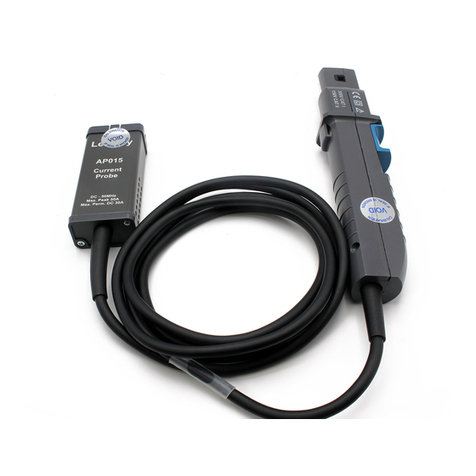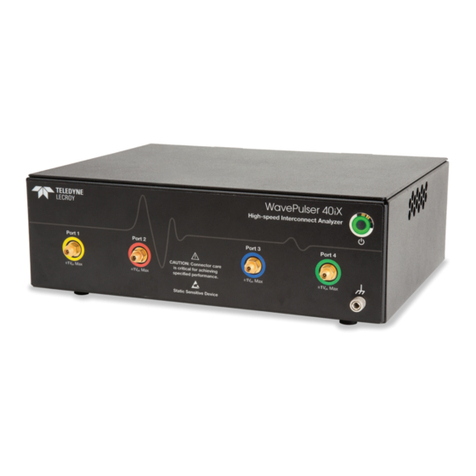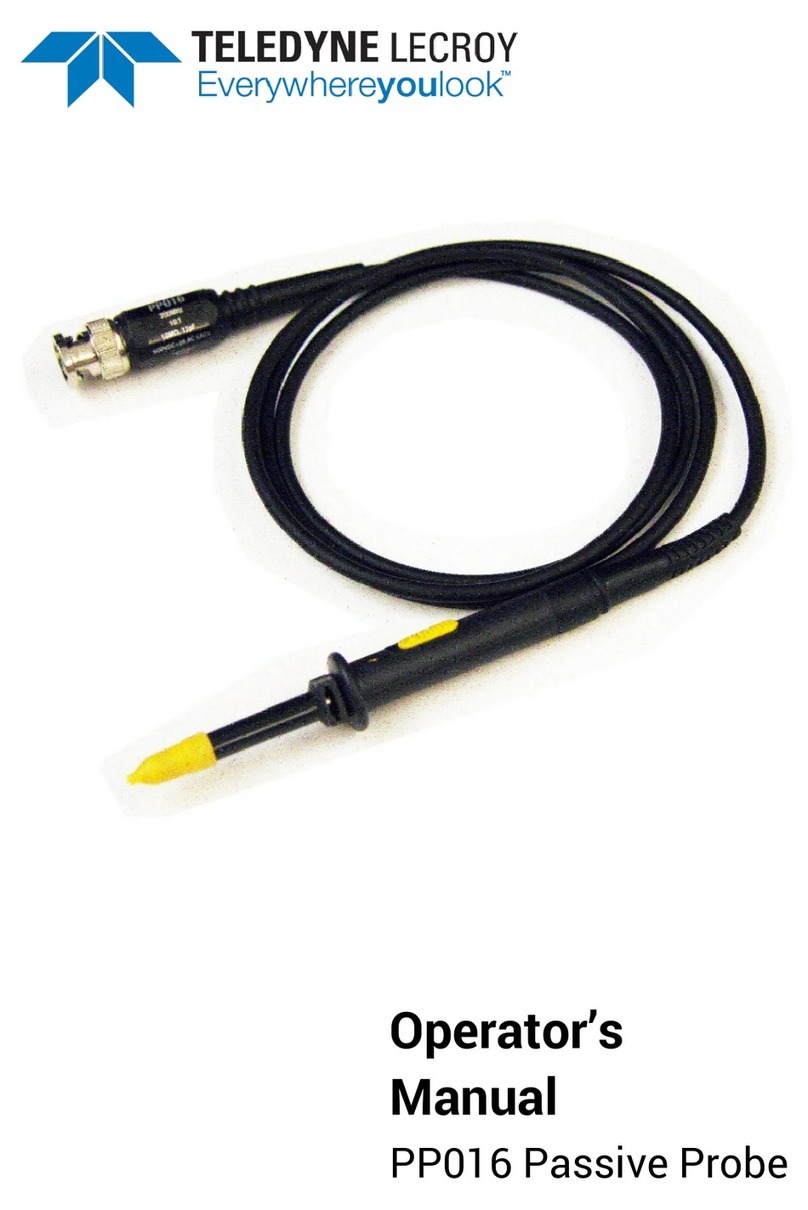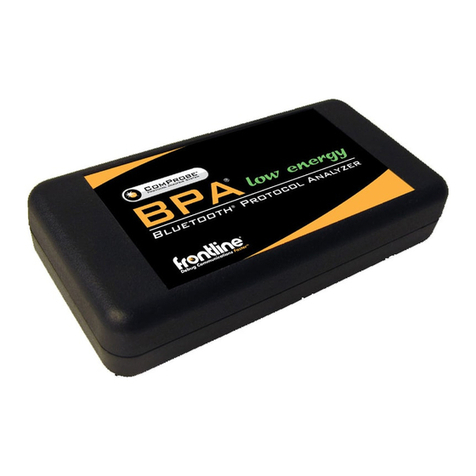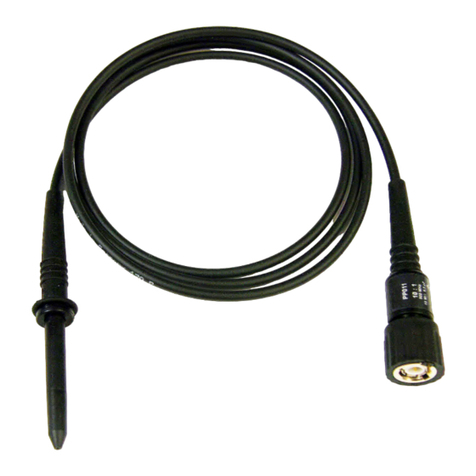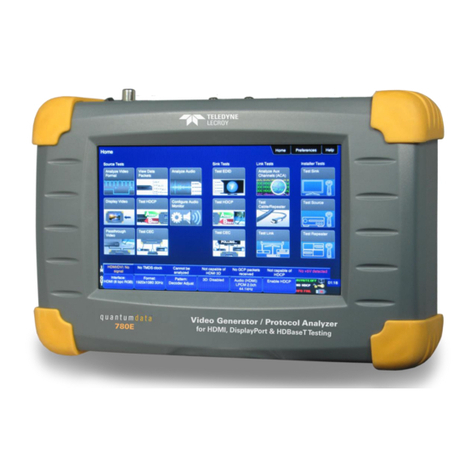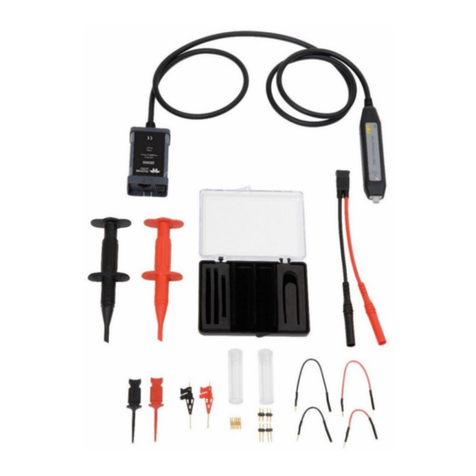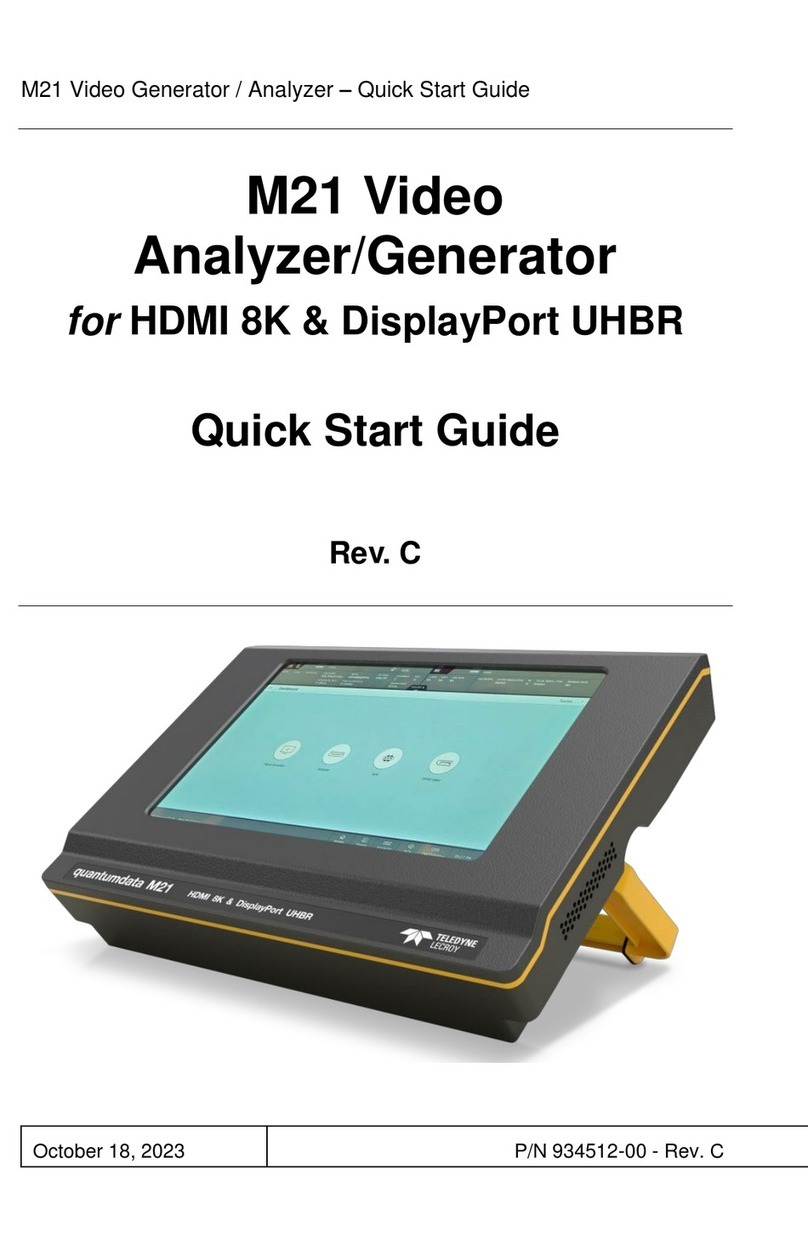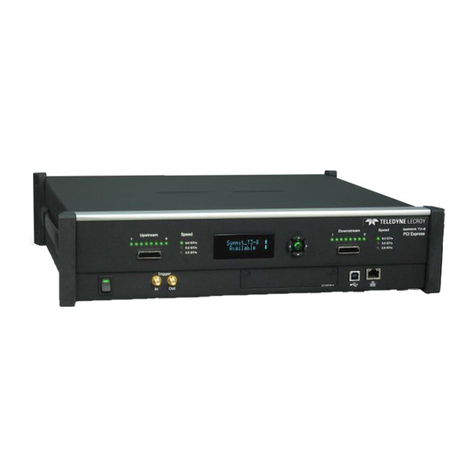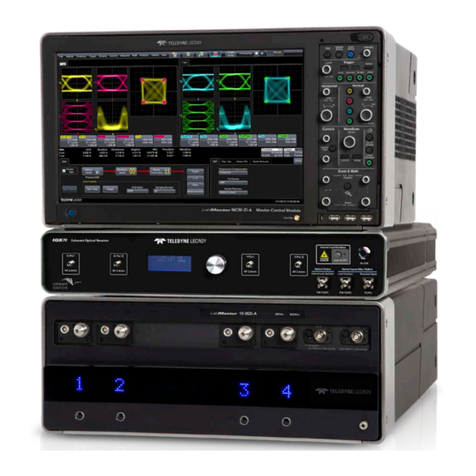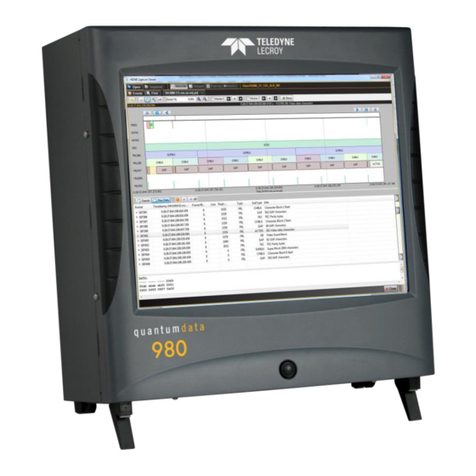
The unique common mode voltage range of the probe
system allows it to be used in the presence of high-
frequency/high-voltage common mode signals, but it is
important to observe all precautions while using it.
WARNING: RF burns or electric shock can occur when
using the HVFO108. The plastic case of the probe
head and tip shields do not provide safe isolation
from hazardous common mode voltages. Do not
access the probe while measuring signals in the RF
burn risk area.
Safety Symbols
These symbols appear on the probe or in documentation.
Terms
The terms isolated and electrically floating are used in
documentation to indicate measurements where there is
no direct conduction path to earth ground.
Compliance
The HVFO108 conforms to the following standards:
IEC/EN 61010-1:2010 - Safety Requirements for Electrical
Equipment for Measurement, Control and Laboratory Use
Part 1: General Requirements
IEC/EN 60825–1 - Safety of Laser Products
Part 1: Equipment Classication and Requirements -
Edition 3 (2014)
US 21CFR Part 1010 - Performance Standards for
Electronic Products: General
US 21CFR Part 1040 - Performance Standards for Light-
Emitting Products
The HVFO108 complies with the applicable
European Union requirements to Directives
2012/19/EU and 2006/66/EC on Waste
Electrical and Electronic Equipment (WEEE) and
Batteries. For information about proper disposal
and recycling of your Teledyne LeCroy product,
visit: teledynelecroy.com/recycle.
Unless otherwise specied, all materials and processes
are compliant with RoHS Directive 2011/65/EU in
its entirety, inclusive of any further amendments or
modications of said Directive.
HIGH VOLTAGE WARNING. Risk of electric
shock or burn.
CAUTION of damage to equipment, or
WARNING of hazard to health. Refer to the
accompanying information in the product
manual to protect against personal injury or
damage. Do not proceed until conditions are
fully understood and met.
ESD CAUTION. Risk of Electrostatic
Discharge (ESD) that can damage equipment
if anti-static measures are not taken.
Laser Safety WARNING.
The overall safety of any system incorporating this
probe is the responsibility of the system owner.
For use only by trained personnel. Not for use in
households or by children.
Use only as specied. Using the probe and/or the
equipment it is connected to in a manner other than
specied may impair the protection mechanisms.
Before use, test the probe with a known source to
ensure it is operating correctly.
Do not overload; observe all terminal ratings. Do not
connect the probe to any circuit that exceeds the CAT,
voltage or current ratings of the oscilloscope terminal,
probe, or probe-accessory combination.
Use only accessories compatible with the probe. Use
only accessories that are rated for the application.
Using accessories other than those shipped with the
probe may create an electrical hazard.
Connect and disconnect properly. Connect the probe
to the oscilloscope before connecting to the circuit
being measured.
Keep the probe body and output cable away from the
circuits being measured. Only tips are intended for
contact with electrical sources.
Do not excessively bend cables. Avoid tight radius
bends, crushing, crimping, twisting or otherwise
stressing.
Do not remove the probe’s casing. Touching exposed
connections may result in electric shock.
Do not disassemble the probe body or remove inside
parts. Refer all service to Teledyne LeCroy personnel.
Use only indoors within the operational environment
listed. Do not use in wet or explosive atmospheres.
Keep product surfaces clean and dry.
Do not use damaged cables. Before each use, check
cables for damage to the protective insulation.
Do not operate with suspected failures. Before each
use, inspect the probe and accessories. If any part is
damaged, cease operation immediately and sequester
the probe from inadvertent use.
Electrical Specications
Bandwidth
(probe + oscilloscope)
150 MHz typical
Input Dynamic Range
1x tip
5x tip
10x tip
20x tip
40x tip
± 1 V
± 5 V
± 10 V
± 20 V
± 40 V
Max. Common Mode Voltage
(either input to ground)
± 35 kV (DC + peak AC)
Max. Input Voltage to Earth
(either input to ground)
± 35 kV (DC + peak AC)
Max. Safe Input Voltage 30 VRMS / 60 VDC (hand-held)
Max. Non-destruct Voltage Lower of 5X dynamic range or 100 V
Environmental Specications
Temperature, Operating 10 °C - 40 °C
Temperature, Charging 0 °C - 40 °C
Temperature, Storage 20 °C - 70 °C
Relative Humidity, Operating 5% - 80% RH (non-condensing) to 30 °C
decreasing linearly to 45% RH at 50 °C
Relative Humidity, Storage 5% - 95% RH (non-condensing)
80% RH above 30 °C
45% RH above 50 °C
Altitude, Operating 3000 m (9842 ft.) maximum
Altitude, Storage 10,000 m (32,807 ft.) maximum
Usage Indoor Use Only
Pollution Degree 2. Per IEC/EN 61010-1:2010, this
is an operating environment where
normally only dry, non-conductive
pollution occurs. Conductivity caused
by temporary condensation should be
expected.
Battery Specications
Charging Interface USB Micro-B
Typical Life > 6 hours
Recharge Time
Oscilloscope USB port
USB charger
5 hours
2.5 hours
Cycle Life > 500 cycles*
* For battery life > 5.5 hours.
Cleaning
Clean only the exterior surfaces of the probe using a soft
cloth dampened with water or 75% isopropyl alcohol
solution. Do not use harsh chemicals or abrasive cleans-
ers. Dry the probe and accessories thoroughly before
making voltage measurements.
CAUTION: The probe casing is not waterproof.
Under no circumstances submerge the probe in
liquid or allow moisture to penetrate it.
Clean ber optic ports with low pressure dry air.
CAUTION: Do not apply solvent to the ports or
insert anything into them other than the ber optic
cable.
Clean the ber optic cable connectors only with wipes/
swabs or solvents appropriate for optical ber, such as
Sticklers Fiber Optic Cleaner or similar.
Calibration
The recommended calibration interval is one year. For
calibration or other service, contact Teledyne LeCroy.
Warranty
For warranty information, see our website at:
teledynelecroy.com/support/service.aspx
Contact
For assistance in the US, contact Technical Support at:
Ph: 800-553-2769 / 845-425-2000
Fax: 845-578-5985
support@teledynelecroy.com
A complete list of regional ofces is available from:
teledynelecroy.com/support/contact.
Not rated for hand-held use above 60 Vdc/30 Vrms.
Do not handle probe tips, leads or any part of the
transmitter at any time if there is any possibility
>60 Vdc is present in the circuit. The plastic case of the
transmitter and tip cable do not provide safe isolation.
Do not connect tip leads to an energized circuit.
Always de-energize the circuit-under-test before
installing or removing tip leads.
Beware when using with high-voltage or high-
frequency signals. Read the manual thoroughly before
use to understand how the probe and accessories are
derated depending on use.
hvfo108-quick-start_12aug22.pdf
General Safety Precautions High Voltage Safety Clearance Requirements
LASER RADIATION
DO NOT EXPOSE USERS O
F TELESCOPIC OPTICS
WARNING: The HVFO108 probe contains laser
sources, exposing which may cause laser burns.
Do not remove any covers from the transmitter or
receiver, or otherwise attempt to disassemble the
probe.
Using controls, adjustments or procedures other than
those specied in the product manual may result in
hazardous radiation exposure.
The probe uses optical bers within a single cable
between the transmitter and receiver. Therefore,
standard optical ber handling practices are required.
Avoid tight radius bends, crushing, crimping, twisting
or otherwise stressing the ber-optic cable.
Minimum cable radius bend is 65 mm; avoid making
loops smaller than 4 in (10.2 cm).
Before each use, inspect the cable for damage such
as tears and other defects.
CLASS 1M LASER PRODUCT
Laser Safety
Maximum safe handling limits for common mode voltages
between the probe body and tip leads with respect to earth ground.
WARNING: Maintain 1m (~40 in) safe clearance
of the probe transmitter and tip in all directions
when connected to an energized circuit. Place the
oscilloscope and any equipment you need to access
at least 1m away from the circuit and transmitter.


